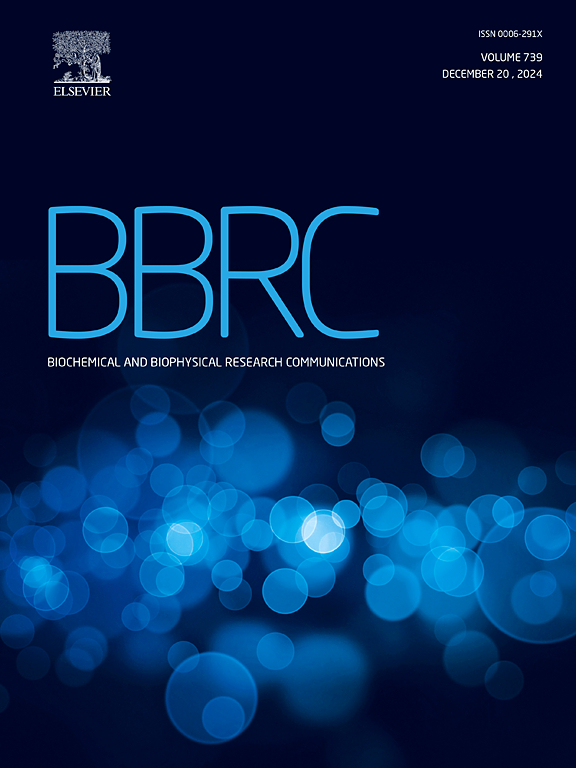Targeting threonine deaminase with chiral Au NPs: A novel strategy for E. coli inhibition
IF 2.5
3区 生物学
Q3 BIOCHEMISTRY & MOLECULAR BIOLOGY
Biochemical and biophysical research communications
Pub Date : 2024-10-29
DOI:10.1016/j.bbrc.2024.150924
引用次数: 0
Abstract
Bacterial infections are becoming a significant threat to global human health due to the growing prevalence of biofilm-related infections and the rise in antibiotic resistance. D/l-cysteine functionalized chiral gold nanoparticles (D/P-Au NPs or L/P-Au NPs) have demonstrated a potent antibacterial effect against E. coli, while the mechanism remains to be elucidated through additional research. Threonine deaminase (TD) is a crucial enzyme involved in branched-chain amino acid (BCAA) biosynthesis in E. coli and is involved in cysteine's antimicrobial effects. This study investigated the interaction between chiral Au NPs (D/P-Au NPs or L/P-Au NPs) and TD as well as its effect on enzyme activity. It demonstrates that chiral Au NPs interact with TD through hydrophobic forces, forming a ground state complex that induces changes in the secondary structure of TD and reduces enzyme activity in a concentration-dependent manner. We found that the exogenous supplementation of isoleucine and valine (2 mg/mL) significantly reduced the antibacterial activity of chiral Au NPs, especially for L/P-Au NPs. The proteomics results indicate that the expression of ilvA and ilvB was down-regulated after L/P-Au NPs treatment, which would interfere with the synthesis of BCAAs. These results demonstrate that chiral Au NPs cause cell death of E. coli partly due to inhibition of TD enzyme activity and the synthesis of branched-chain amino acids.
用手性金纳米粒子靶向苏氨酸脱氨酶:抑制大肠杆菌的新策略
由于与生物膜相关的感染日益普遍以及抗生素耐药性的增加,细菌感染正成为全球人类健康的重大威胁。D/l-半胱氨酸功能化手性金纳米粒子(D/P-Au NPs 或 L/P-Au NPs)对大肠杆菌具有强效抗菌作用,但其作用机制仍有待进一步研究阐明。苏氨酸脱氨酶(TD)是参与大肠杆菌支链氨基酸(BCAA)生物合成的关键酶,也参与了半胱氨酸的抗菌作用。本研究探讨了手性 Au NPs(D/P-Au NPs 或 L/P-Au NPs)与 TD 之间的相互作用及其对酶活性的影响。研究表明,手性 Au NPs 通过疏水力与 TD 相互作用,形成基态复合物,诱导 TD 二级结构发生变化,并以浓度依赖的方式降低酶活性。我们发现,外源补充异亮氨酸和缬氨酸(2 mg/mL)会显著降低手性 Au NPs 的抗菌活性,尤其是 L/P-Au NPs。蛋白质组学结果表明,L/P-Au NPs 处理后,ilvA 和 ilvB 的表达下调,这将干扰 BCAAs 的合成。这些结果表明,手性 Au NPs 导致大肠杆菌细胞死亡的部分原因是抑制了 TD 酶的活性和支链氨基酸的合成。
本文章由计算机程序翻译,如有差异,请以英文原文为准。
求助全文
约1分钟内获得全文
求助全文
来源期刊
CiteScore
6.10
自引率
0.00%
发文量
1400
审稿时长
14 days
期刊介绍:
Biochemical and Biophysical Research Communications is the premier international journal devoted to the very rapid dissemination of timely and significant experimental results in diverse fields of biological research. The development of the "Breakthroughs and Views" section brings the minireview format to the journal, and issues often contain collections of special interest manuscripts. BBRC is published weekly (52 issues/year).Research Areas now include: Biochemistry; biophysics; cell biology; developmental biology; immunology
; molecular biology; neurobiology; plant biology and proteomics

 求助内容:
求助内容: 应助结果提醒方式:
应助结果提醒方式:


